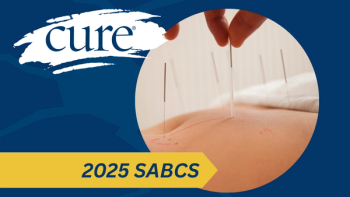
Investigational Combo Therapy Offers ‘High Hopes’ in Treating Rare Gastrointestinal Cancer
Results of a preliminary clinical trial show that MK-1775 — an investigational therapy — as a single agent, or in combination with Ayvakit, may be effective in the treatment of gastrointestinal stromal tumors. However, one of the study’s authors notes that further research is needed to determine a benefit in patients.
Results of a preclinical trial demonstrated that adding MK-1775 — an investigational Wee1 inhibitor — to Ayvakit (avapritinib) improved efficacy and time to treatment resistance in gastrointestinal stromal tumors (GIST).
And while the study results, which were published in JCI Insight, show a possible development in treating gastrointestinal stromal tumors, one of the study’s authors noted that research outside of a lab setting is needed to confirm efficacy in patients.
Gastrointestinal stromal tumors are the most common sarcomas (tumors that develop in the bones and soft tissue such as fat and muscle) that affect the gastrointestinal tract.
In a recent interview with CURE®, one of the study’s authors, Lori Rink, an assistant professor of molecular therapeutics at Fox Chase Cancer Center in Philadelphia, discussed the results of the preliminary study, as well as what further research is needed.
CURE®: What led you and your colleagues to want to conduct this research?
Rink: We’ve been studying gastrointestinal stromal tumors for years, and we have a particular interest in resistance to the small molecule inhibitors that are (currently) the standard of care. We know a lot now about GIST, as they're commonly called, and we know that not all GISTs are the same. There are now three different subtypes of GIST, and we sought to identify new targets, either kind of widespread in all GIST or possibly subtype specific. If we could identify some new targets, perhaps we could identify some new therapies to go after these tumors that are resistant to the standard of care.
How was the research conducted?
We took tumors from patients that we had at Fox Chase Cancer Center, and we performed something called kinome profiling, where we looked at all of the kinases. Kinases are proteins that are important in all cells; they activate cell signaling pathways in the cells that regulate things like cell growth, cell death and angiogenesis, (as well as) other parts of cells and metabolism. And we could quantify the kinases that were in these tumors.
What did the study results show?
We wanted to see (if) different subtypes (of GIST) have different kinds of profiles; there are around 520 kinases in human cells. And so, what we found were that the different subtypes, even though they’re all considered GIST, had different profiles in terms of what kinases were activated or downregulated. And then we also saw some kind of commonalities among all the GIST subtypes. And so, our idea was, could we see if any of those kinases were functionally relevant and important for GIST cell survival? From there, we took an approach where we genetically knocked down the kinases that we've identified from the profiling studies to see if by knocking any of those kinases down, we could affect the growth of these tumor cells.
Were you able to affect the growth of those tumor cells?
Yes. We were able to look at a number of the kinases we identified in the paper that we published recently, called Wee1. Wee1 is an interesting kinase because it's involved in the cell cycle. When we did these genetic modifications to the GIST cells in culture, we saw that by knocking Wee1 down, we were able to cause cell death of these tumor cells. We also took it a step further and found an inhibitor that selectively targets Wee1; that inhibitor is in clinical trials and under investigation in other cancer types, but not in GIST. When we used that selective inhibitor, we were able to see cell death in our GIST cells as a single agent, but even greater when we combined it with (Ayvakit), which is a new drug that has just recently been approved in GIST.
While still early, what is the significance of these results and what do they mean for patients?
One of the interesting things we found is that this drug combination — the Wee1 inhibitor in combination with (Ayvakit) — worked particularly well and had a greater synergistic potential in GIST cells and tumors growing in mice that had the PDGFRA D842V mutation. This is a particular subtype of GIST that have a specific gain of function mutation. And what we found was that in these cells, and in these tumors, we could achieve a greater toxicity. One of the issues that patients face when they take (Ayvakit) is that there are some side effects. Some of these are some cognitive side effects. Our thinking is that by identifying these two drugs that work well together, there's a potential to decrease the doses of both of these drugs and potentially decrease or limit the toxicities — especially those cognitive toxicities that's associated with higher doses of (Ayvakit).
What further research is needed?
The pipeline of this is really doing the preclinical testing. This paper was kind of the identification that (Wee1) may be a plausible target in GIST. We are really enthusiastic about this target and from everything we've done so far, there are definitely high hopes. But we have still a few more preclinical animal studies to do the testing of the Wee1 inhibitor, either as a single agent or in combination. And then from there, there's always kind of our hope is that we're able to translate the findings that we do preclinically in the lab to the patient setting with the initiation of a clinical trial to test this inhibitor, with a particular focus in the PDGFRA D842V-mutant GIST subtype of population.
For more news on cancer updates, research and education, don’t forget to





